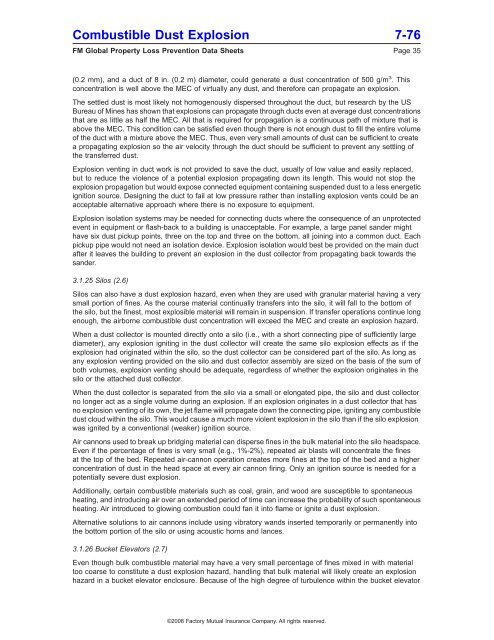DS 7-76 Prevention and Mitigation of Combustible Dust ... - FM Global
DS 7-76 Prevention and Mitigation of Combustible Dust ... - FM Global
DS 7-76 Prevention and Mitigation of Combustible Dust ... - FM Global
Create successful ePaper yourself
Turn your PDF publications into a flip-book with our unique Google optimized e-Paper software.
<strong>Combustible</strong> <strong>Dust</strong> Explosion 7-<strong>76</strong><br />
<strong>FM</strong> <strong>Global</strong> Property Loss <strong>Prevention</strong> Data Sheets Page 35<br />
(0.2 mm), <strong>and</strong> a duct <strong>of</strong> 8 in. (0.2 m) diameter, could generate a dust concentration <strong>of</strong> 500 g/m 3 . This<br />
concentration is well above the MEC <strong>of</strong> virtually any dust, <strong>and</strong> therefore can propagate an explosion.<br />
The settled dust is most likely not homogenously dispersed throughout the duct, but research by the US<br />
Bureau <strong>of</strong> Mines has shown that explosions can propagate through ducts even at average dust concentrations<br />
that are as little as half the MEC. All that is required for propagation is a continuous path <strong>of</strong> mixture that is<br />
above the MEC. This condition can be satisfied even though there is not enough dust to fill the entire volume<br />
<strong>of</strong> the duct with a mixture above the MEC. Thus, even very small amounts <strong>of</strong> dust can be sufficient to create<br />
a propagating explosion so the air velocity through the duct should be sufficient to prevent any settling <strong>of</strong><br />
the transferred dust.<br />
Explosion venting in duct work is not provided to save the duct, usually <strong>of</strong> low value <strong>and</strong> easily replaced,<br />
but to reduce the violence <strong>of</strong> a potential explosion propagating down its length. This would not stop the<br />
explosion propagation but would expose connected equipment containing suspended dust to a less energetic<br />
ignition source. Designing the duct to fail at low pressure rather than installing explosion vents could be an<br />
acceptable alternative approach where there is no exposure to equipment.<br />
Explosion isolation systems may be needed for connecting ducts where the consequence <strong>of</strong> an unprotected<br />
event in equipment or flash-back to a building is unacceptable. For example, a large panel s<strong>and</strong>er might<br />
have six dust pickup points, three on the top <strong>and</strong> three on the bottom, all joining into a common duct. Each<br />
pickup pipe would not need an isolation device. Explosion isolation would best be provided on the main duct<br />
after it leaves the building to prevent an explosion in the dust collector from propagating back towards the<br />
s<strong>and</strong>er.<br />
3.1.25 Silos (2.6)<br />
Silos can also have a dust explosion hazard, even when they are used with granular material having a very<br />
small portion <strong>of</strong> fines. As the course material continually transfers into the silo, it will fall to the bottom <strong>of</strong><br />
the silo, but the finest, most explosible material will remain in suspension. If transfer operations continue long<br />
enough, the airborne combustible dust concentration will exceed the MEC <strong>and</strong> create an explosion hazard.<br />
When a dust collector is mounted directly onto a silo (i.e., with a short connecting pipe <strong>of</strong> sufficiently large<br />
diameter), any explosion igniting in the dust collector will create the same silo explosion effects as if the<br />
explosion had originated within the silo, so the dust collector can be considered part <strong>of</strong> the silo. As long as<br />
any explosion venting provided on the silo <strong>and</strong> dust collector assembly are sized on the basis <strong>of</strong> the sum <strong>of</strong><br />
both volumes, explosion venting should be adequate, regardless <strong>of</strong> whether the explosion originates in the<br />
silo or the attached dust collector.<br />
When the dust collector is separated from the silo via a small or elongated pipe, the silo <strong>and</strong> dust collector<br />
no longer act as a single volume during an explosion. If an explosion originates in a dust collector that has<br />
no explosion venting <strong>of</strong> its own, the jet flame will propagate down the connecting pipe, igniting any combustible<br />
dust cloud within the silo. This would cause a much more violent explosion in the silo than if the silo explosion<br />
was ignited by a conventional (weaker) ignition source.<br />
Air cannons used to break up bridging material can disperse fines in the bulk material into the silo headspace.<br />
Even if the percentage <strong>of</strong> fines is very small (e.g., 1%-2%), repeated air blasts will concentrate the fines<br />
at the top <strong>of</strong> the bed. Repeated air-cannon operation creates more fines at the top <strong>of</strong> the bed <strong>and</strong> a higher<br />
concentration <strong>of</strong> dust in the head space at every air cannon firing. Only an ignition source is needed for a<br />
potentially severe dust explosion.<br />
Additionally, certain combustible materials such as coal, grain, <strong>and</strong> wood are susceptible to spontaneous<br />
heating, <strong>and</strong> introducing air over an extended period <strong>of</strong> time can increase the probability <strong>of</strong> such spontaneous<br />
heating. Air introduced to glowing combustion could fan it into flame or ignite a dust explosion.<br />
Alternative solutions to air cannons include using vibratory w<strong>and</strong>s inserted temporarily or permanently into<br />
the bottom portion <strong>of</strong> the silo or using acoustic horns <strong>and</strong> lances.<br />
3.1.26 Bucket Elevators (2.7)<br />
Even though bulk combustible material may have a very small percentage <strong>of</strong> fines mixed in with material<br />
too coarse to constitute a dust explosion hazard, h<strong>and</strong>ling that bulk material will likely create an explosion<br />
hazard in a bucket elevator enclosure. Because <strong>of</strong> the high degree <strong>of</strong> turbulence within the bucket elevator<br />
©2008 Factory Mutual Insurance Company. All rights reserved.

















